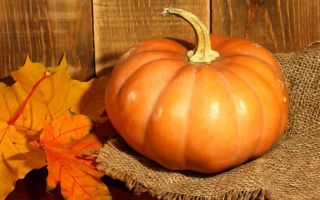Content
- 1 What is pumpkin
- 2 Vitamins and minerals in pumpkin
- 3 How many calories are in a pumpkin
- 4 The benefits of pumpkin for human health
- 5 Is it possible to pumpkin during pregnancy
- 6 Is pumpkin good for nursing mothers
- 7 At what age can pumpkin be given to children
- 8 Healing properties of pumpkin
- 9 Slimming pumpkin
- 10 The benefits and harms of raw pumpkin
- 11 The benefits of pumpkin, depending on the type of processing
- 12 What are the benefits of flowers, leaves and stems of pumpkin
- 13 Is it okay to eat pumpkin every day
- 14 How to use pumpkin for medicinal purposes
- 15 The use of pumpkin in cosmetology
- 16 Harm of pumpkin and contraindications to use
- 17 How to choose a pumpkin
- 18 How to store pumpkin
- 19 Conclusion
- 20 Reviews
The benefits and harms of pumpkin are an important issue, since this huge vegetable is very often found on tables in fresh and processed forms. To appreciate a product at its true worth, you need to study the composition and characteristic properties.
What is pumpkin
A pumpkin is a herbaceous plant with a well-developed root system, creeping long stems and large leaves on large petioles. The vegetable blooms in large yellow or orange single flowers. The main value in the plant is represented by its fruits - huge false berries, or pumpkins, reaching a mass of 4 to 10 kg.
Pumpkins are round or flattened in shape, usually ranging in color from yellow to orange-red. The flesh of a vegetable of different varieties can also vary greatly in color - from white to reddish-yellow.
The homeland of the vegetable is the southern regions of the globe - Persia, Asia Minor, Central America. The vegetable came to Russia only in the 19th century, but quickly gained popularity; at the moment, pumpkin is grown everywhere except in the northernmost regions.
Vitamins and minerals in pumpkin
The health benefits of a vegetable are determined by the high content of valuable substances in its composition. The pulp and other parts of the plant contain:
- vitamins A, E and C;
- B vitamins - thiamine and riboflavin, pyridoxine and pantothenic acids, folic acid;
- niacin, or vitamin PP;
- useful minerals - iron, calcium, phosphorus and zinc;
- potassium, sulfur, chlorine and manganese;
- iodine and cobalt;
- fluorine and sodium;
- organic acids and sugary substances;
- ash and starch;
- cellulose.
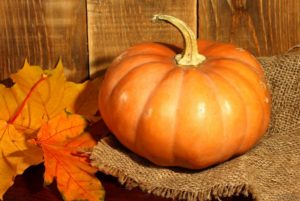
How many calories are in a pumpkin
The nutritional value of a vegetable largely depends on the processing method.
|
Pumpkin processing type |
Calorie content per 100 g |
|
Raw |
25 kcal |
|
Boiled or steamed |
38 kcal |
|
Baked |
45 kcal |
|
Dried |
68 kcal |
Thus, the beneficial properties of raw pumpkin include its reduced calorie content. But any processing significantly increases the nutritional value.
The benefits of pumpkin for human health
The benefit of pumpkin dishes is that the valuable substances in the vegetable have a positive effect on the entire body. In particular, the product:
- has a positive effect on vision;
- normalizes the intestines and stomach, regulates metabolism;
- increases the elasticity of blood vessels and lowers blood pressure;
- removes toxins, toxins and excess fluids from the body, which contributes to healthy kidney function;
- promotes cell renewal and tissue repair;
- energizes and has a calming effect on the nervous system;
- strengthens the immune system and increases resistance to colds.
The benefits of pumpkin for women
The benefits of pumpkin for a woman's body is that the vegetable helps to maintain beauty and well-being. It improves the condition of the skin and restores a healthy complexion, helps to maintain a healthy weight and is of great benefit for losing weight. The tonic properties of the vegetable are in demand during periods of loss of strength or during menstruation.
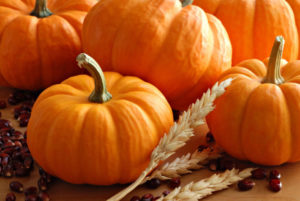
The benefits of pumpkin for men
For the male body, the acids in the vegetable are most beneficial, protecting against diseases in the genitourinary sphere and against a decrease in potency. The vegetable contains a lot of zinc - this element prevents the development of inflammation of the prostate gland. The beneficial properties of the vegetable also affect the cardiovascular system - when consumed, the risk of heart attacks and strokes is reduced.
Pumpkin for the elderly
For the elderly, the vegetable is very useful due to its high content of potassium, iron, vitamins B and C, carotene and ascorbic acid. It is important to note that the vegetable is easily digested - older people do not have any difficulties with its digestion. The benefits of raw pumpkin passed through a blender will be especially great. The vegetable is of great benefit for diseases of the heart, blood vessels and kidneys.
Is it possible to pumpkin during pregnancy
In the absence of allergies, you can use a healthy vegetable while carrying a child. The beneficial properties of pumpkin during pregnancy are that it eliminates puffiness, prevents constipation and supplies nutrients to the body. Calcium and phosphorus in the vegetable are very useful for both the fetus and the woman herself.
In addition, with toxicosis, the benefits of fried pumpkin are useful. Of course, the benefits and harms of pumpkin for pregnant women depend on the volume of the product - overuse of the vegetable can lead to diarrhea.

Is pumpkin good for nursing mothers
Breastfeeding pumpkin can be introduced into the diet after childbirth as early as 10 days. The product rarely causes a negative reaction in a child, allows a woman to maintain a normal weight. And the restorative and healing properties of the vegetable help the tissues of the female body to recover faster.
At what age can pumpkin be given to children
The benefits of pumpkin for babies are unconditional - the vegetable is introduced into the children's diet from 6 months. You can give it in the form of boiled pulp puree. The benefits of pumpkin for children are that the vegetable contributes to the rapid growth of the child and the normal development of the nervous system. With its use, the child's sleep is normalized, brain activity improves.
Healing properties of pumpkin
A vegetable not only acts as a prevention of diseases, but also helps in the treatment of ailments. It is especially useful for certain diseases.
With diabetes mellitus
The benefits and harms of pumpkin for diabetics depend on the form in which the vegetable is consumed. The glycemic index of raw pulp is only 25 units. The benefits of pumpkin for diabetics in this case will be expressed in the fact that the vegetable will lower sugar levels and help the liver.
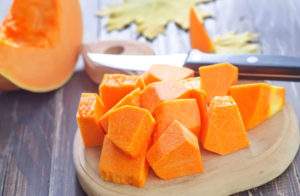
But boiled and baked vegetables are prohibited for diabetics. Their glycemic indices are too high, and the use of the product will only harm health.
With gout
A healthy vegetable contains a lot of water, fiber and pectins, therefore it plays an important role in water-salt metabolism. With gout, the vegetable will help normalize uric acid levels, remove toxins and prevent salt deposition in the joints. The product is allowed to be consumed daily - its properties will not harm.
With gastritis and ulcers
The vegetable is distinguished by excellent digestibility; if consumed raw, boiled or baked, there will be no harm to an irritated stomach. On the contrary, the product will promote healing of mucous membranes, reduce pain and help cope with nausea.
However, the health benefits and harms of pumpkin for gastritis depend on the acidity of the stomach. With a reduced production of gastric juice, there will be little benefit - the vegetable will not be able to speed up digestion.
With liver diseases
The vegetable is great for detoxifying the liver. The beneficial substances present in it contribute to the renewal of liver cells, prevent hepatitis and cirrhosis, and promote good bile flow.
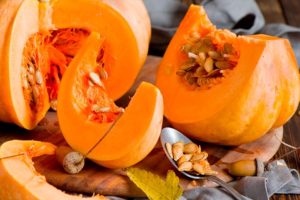
You can use a vegetable for liver ailments daily, as part of salads and main courses. There are also vegetable-based recipes designed specifically to cleanse this organ.
With pancreatitis
As a rule, the product does not harm the inflammation of the pancreas - you can enter the vegetable into the diet within 3 days after the pain subsides. However, before eating, the pulp must be boiled.
The benefits of pumpkin for the pancreas depend on the volume - only 300 g of the product can be eaten per day, dividing the total amount into small portions. Pumpkin juice is contraindicated in pancreatitis, it contains too high a concentration of active substances.
For tuberculosis and cancer
The useful properties of the product are so great that they are able to help even with tuberculosis and oncological ailments. A vegetable in a constant diet helps to suppress the growth of tuberculosis bacilli, so the vegetable is good for both prevention and treatment of the disease.
As for the fight against cancer, the antioxidants in the vegetable slow down the growth of malignant cells. Any part of the product can be used for therapy, not only the pulp, but also juice or pumpkin seed oil.
The use of a vegetable must be combined with medicines, then there will be health benefits.

Slimming pumpkin
When dieting, pumpkin can be eaten raw - the unprocessed vegetable is the least calorie. The use of raw pumpkin for the body is that it speeds up metabolic processes, therefore, during weight loss, food is digested faster, and toxins are actively released from the intestines.
There are special diets based on the product; you can use fresh vegetable juice to quickly get rid of extra pounds. Pumpkin will bring special benefits in the morning - it will not only saturate the body with vitamins and minerals, but also quickly activate metabolic processes, and will also give a boost of vivacity.
The benefits and harms of raw pumpkin
Untreated pulp contains the greatest amount of valuable substances, besides, raw vegetables have very few calories - this is its value. However, the benefits and harms of raw pumpkin for the body depend on the quality of the vegetable - it is important that it be grown without the use of nitrates and pesticides.
The benefits of raw pumpkin will be especially great for those who suffer from gastritis with high acidity or overweight. But with exacerbations of pancreatitis and colitis and with low-acid gastritis, the vegetable will rather harm.
The benefits of pumpkin, depending on the type of processing
With different cooking methods, the benefits of the product vary slightly. You need to know what properties a vegetable has in one form or another.
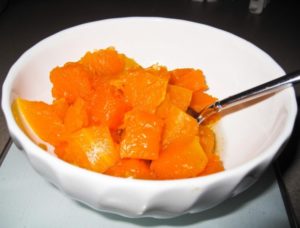
Boiled
When steamed, most of the nutrients are retained in the pumpkin pulp. The benefits of steamed pumpkin are low in calories, the vegetable helps to reduce body weight and helps remove toxins from the body. The product prepared in a water bath relieves swelling, the beneficial properties of pumpkin for the body of women are that the product helps to fight toxicosis.
The boiled product will harm only in diabetes, since its glycemic index is quite high, and with diarrhea due to a laxative effect.
Boiled
The benefits of boiled pumpkin for the body are that it helps fight obesity, prevents the development of anemia, and is very well absorbed even with irritated stomach mucous membranes. Boiled pulp is introduced into the children's diet early, and many cosmetic masks are prepared on its basis.
However, with diabetes mellitus, the benefits and harms of pumpkin are ambiguous - it is better to refuse a boiled vegetable. The product will harm in case of diarrhea and ulcers.
Dried
Drying is a great way to preserve the beneficial properties of the product for a long time. The benefits and harms of dried pumpkin are that it has a beneficial effect on the digestive processes, is a good choleretic, increases endurance and strengthens memory.
However, you should not use the product if you have a tendency to diarrhea - the vegetable will increase intestinal motility and will only aggravate the situation.
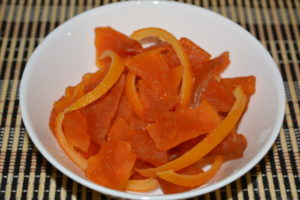
Baked
Baking in the oven is another good way to preserve the valuable properties of the product. Baked pumpkin has a good effect on blood vessels and the heart system, helps the liver and cleanses the kidneys. But eating it is not recommended for diabetes and chronic stomach ailments - in such situations, the vegetable will be harmful.
What are the benefits of flowers, leaves and stems of pumpkin
The pulp of the plant is far from the only valuable part. In folk medicine, the benefits of pumpkin leaves, its flowers and crushed stems are actively used. The green parts of the plant also contain a huge amount of nutrients.
The benefits of pumpkin leaves are especially appreciated in the fight against oncology - plant-based decoctions are taken along with official medicines. Remedies from leaves and stems are a good anticonvulsant drug, increase immunity, and have a good effect on reproductive capacity.
The flowers of the plant are highly valued for their content of useful propolis - a natural anti-inflammatory and strengthening agent.
Is it okay to eat pumpkin every day
If there are no contraindications, that is, the vegetable can be in unlimited quantities - this will only benefit. Of course, you should not overeat - excessive consumption of any product is fraught with problems with the intestines and stomach.
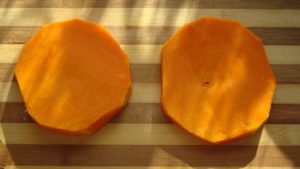
How to use pumpkin for medicinal purposes
The healing properties of pumpkin are found in many homemade recipes. The vegetable allows you to improve your well-being for a variety of ailments.
Pumpkin for constipation
The benefits and harms of fresh pumpkin are in its laxative effect. To eliminate constipation, it is enough to prepare such a dish - grate 100 g of vegetables, carrots and 2 apples, fill them with a teaspoon of olive oil and eat in the morning or evening.
Steamed pumpkin will be beneficial in treating constipation - it can be mixed with honey, the dish will also have a relaxing effect on the intestines. The benefits of stewed pumpkin will also come in handy - it will enhance peristalsis and help remove toxins.
For the prevention of constipation, you can use the vegetable in any form - the fiber in the product will help improve intestinal functions.
Pumpkin from pressure
For hypertension, the following vegetable-based dish will help:
- 200 g of grated pumpkin pulp are mixed with 50 g of steamed and chopped raisins;
- add 50 g of sprouted wheat grains, crushed in a blender;
- complement the ingredients with 50 g of honey and mix well.
The tool should be taken over a month for 250 g for breakfast. The benefits of pumpkin on an empty stomach will be that it cleanses and strengthens blood vessels, thereby helping to reduce blood pressure.
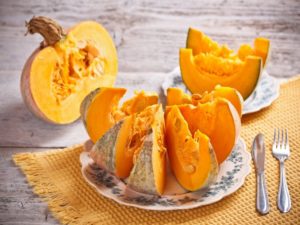
Flowers and cuttings of pumpkin from edema
To remove excess fluid from the body, it is necessary to crush and mix 10 g of pumpkin cuttings, 5 g of flowers, as well as 10 g of blackcurrant leaves. The raw materials are poured with water, boiled, and then boiled for another quarter of an hour over low heat.
The chilled drink is filtered and taken twice a day for several sips. The benefits of pumpkin broth are diuretic properties - the swelling goes away very quickly.
Pumpkin flowers for the prevention of atherosclerosis
In order to prevent the accumulation of cholesterol plaques and the occurrence of atherosclerosis, such a remedy is prepared:
- 15 g of crushed pumpkin flowers and a handful of crushed hawthorn fruits are mixed together;
- the ingredients are poured into a small container and poured with vodka, and then removed to infuse for a week;
- when the product is ready, filter it and drink 20 drops twice a day with a couple of sips of water.
You need to continue treatment for no longer than 10 days, otherwise the tincture may be harmful.
Pumpkin liver cleaning
The benefits of pumpkin for the liver are manifested in the fact that the vegetable effectively removes toxins from the body. Usually pumpkin seed oil is used for cleansing - it is drunk on a teaspoon for a month from morning to breakfast. Then they take a break of the same duration and, if necessary, repeat the course.
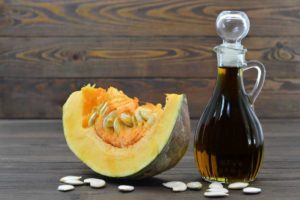
Pumpkin with honey for liver treatment
Raw pumpkin has liver benefits in another popular recipe. The top of a fresh vegetable is carefully cut off, the seed cavities are taken out and liquid honey is poured onto the vacant space. After that, the cut off top is placed on top, like a lid, the edges are covered with dough and the vegetable is placed in a dark cool place for 1.5 weeks.
After this period, honey, which has absorbed all the valuable properties of a vegetable, is consumed three times a day, 20 g before meals. The course of treatment is continued for no more than 3 weeks.
Pumpkin pulp for burns and eczema
The medicinal properties of pumpkin in folk medicine are also used externally. In case of burns, skin lesions and dermatological ailments, it is recommended to lubricate sore spots with pumpkin pulp gruel several times a day. The tool promotes faster tissue regeneration.
The use of pumpkin in cosmetology
The benefits of fresh pumpkin are actively used for skin care. The properties of the vegetable help to get rid of acne and acne. You can see the benefits of pumpkin pulp in the video about cosmetological use - the product softens the skin and slightly tightens the oval of the face
The following mask will help improve the condition of dry skin:
- grind fresh pulp in the amount of 3 large spoons;
- mixed with a large spoonful of olive oil;
- applied to the face for 20 minutes.
The cosmetic benefit of raw pumpkin for a woman's body is that the pulp of the vegetable nourishes the cells with water and vitamins - the skin is renewed, becomes softer and more elastic.
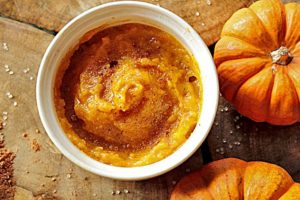
Harm of pumpkin and contraindications to use
The benefits of the product cover all body systems. But with some ailments, eating a vegetable is undesirable. Namely:
- with low acid gastritis and intestinal colitis;
- with sensitive tooth enamel;
- in the presence of food intolerance.
With care, the properties of the vegetable should be used for diabetes, ulcers and pancreatitis. It is necessary to first check in what form it will be beneficial and in what form it will be harmful.
How to choose a pumpkin
The benefits and harms of pumpkin for the health of women and men depend on the quality of the vegetable. When choosing a product, you need to follow a number of rules.
- First of all, you need to look at the tail of the vegetable. If you can see that it was cut, then most likely the fruit did not have time to ripen. In a mature vegetable, the stalk falls off on its own.
- A good fruit should have a firm skin. Before buying, you can lightly press on it with your fingernail - if the skin does not break, the vegetable is ripe enough.
- It is best to buy a whole product, not a cut product. A vegetable with an open flesh spoils faster and may not be quite fresh at the time of purchase.
- The ideal weight for a vegetable is 3 to 5 kg. You should not choose a product exclusively by its large size, the pulp may be watery or dryish.
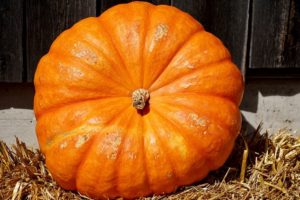
It depends on the variety, but if the inside of the vegetable is rich orange, it means that it contains a lot of vitamin A. Such a fruit will be especially useful for eyesight, skin and hair.
How to store pumpkin
A small fruit can be placed in the refrigerator - if the peel is intact, the vegetable can retain its beneficial properties for up to 3 months. Individual slices must be wrapped in cling film or foil, in which case they will lie in the refrigerator for a month.
You can save the product up to a year by deep freezing. To do this, the vegetable is cut into thin slices, placed in special containers or bags and sent to the freezer, where the temperature is set to no higher than - 18 ° C.
Conclusion
The benefits and harms of pumpkin are determined by the quality of the vegetable and the absence of strict contraindications. If the product is not prohibited for use, then the benefits from it will be for all body systems, even with serious ailments.


